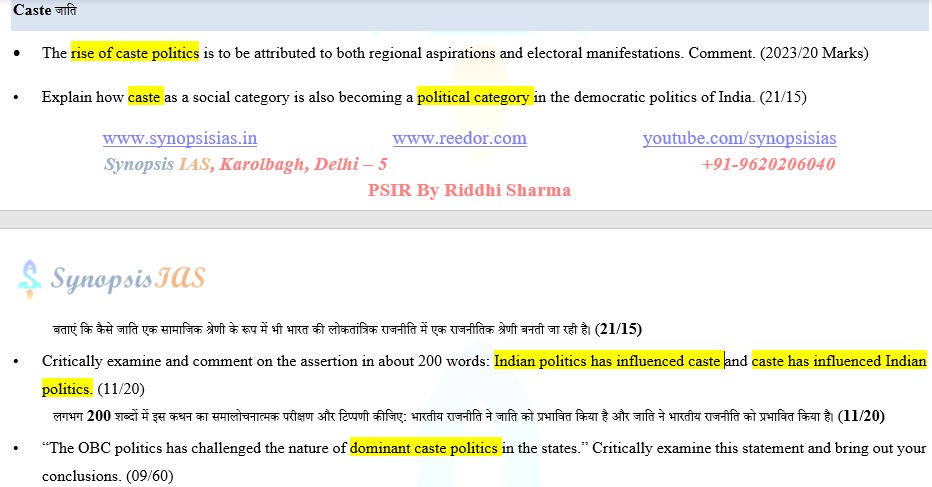PSIR 8a. The rise of caste politics is to be attributed to both regional aspirations and electoral manifestations. Comment. UPSC 2023, 20 Marks
The rise of caste politics in India is a complex interplay of regional aspirations and electoral dynamics. While it has empowered marginalized groups and advanced social justice, it also faces criticism for its potentially divisive nature. Balancing the aspirations of diverse caste groups while ensuring overall development remains a significant challenge for Indian democracy.
This article is part of Synopsis IAS Political Science and International Relations (PSIR) Optional Course.

Introduction:
The rise of caste politics in India is a complex phenomenon driven by a combination of regional aspirations and electoral manifestations. This intricate interplay of factors has significantly shaped the country's political landscape.
Regional Aspirations:
Caste as a Marker of Identity:
Historically, caste has been a potent marker of social identity in India.
People often identify more closely with their caste or sub-caste than with broader regional or national identities.
Caste-based communities have distinct cultural, social, and economic interests that drive their political aspirations.
Empowerment Through Representation:
Many marginalized caste groups historically faced social and economic discrimination.
They seek political empowerment to address historical injustices and secure a better future.
Regional political parties often emerge as platforms to champion the cause of specific castes or communities.
Electoral Manifestations:
Vote Bank Politics:
Political parties recognize the significance of caste as a vote bank.
Parties strategically align with specific caste groups to secure their support during elections.
This often involves offering economic incentives, reservations, and targeted development programs.
Caste-Based Parties:
The emergence of caste-based political parties is a direct electoral manifestation.
Parties like the Bahujan Samaj Party (BSP), Samajwadi Party (SP), and Rashtriya Janata Dal (RJD) prioritize caste-based politics.
They mobilize caste groups for electoral gains, leading to the consolidation of specific caste votes.
Electoral Strategies:
Political parties tailor their campaign strategies to cater to caste-based sentiments.
Candidate selection, manifestos, and rhetoric often revolve around caste issues.
Caste-based considerations can even determine alliances and coalition politics at the state and national levels.
Significance:
Empowerment of Marginalized Castes:
Caste politics have been instrumental in giving a voice to marginalized and oppressed caste groups.
This has led to policies like reservations in education and government jobs, aimed at uplifting these communities.
Social Justice Agenda:
Caste-based parties often champion social justice and advocate for the rights of historically marginalized groups.
They have influenced national policies on issues like land reforms and affirmative action.
Criticism:
Divisive Nature:
Critics argue that caste politics can be divisive, emphasizing identity over broader national interests.
It may lead to inter-caste conflicts and hinder social cohesion.
Lack of Development Focus:
Some critics contend that caste politics can prioritize identity issues over development and governance.
This may result in inefficient governance and lack of focus on critical development challenges.
Conclusion:
The rise of caste politics in India is a complex interplay of regional aspirations and electoral dynamics. While it has empowered marginalized groups and advanced social justice, it also faces criticism for its potentially divisive nature. Balancing the aspirations of diverse caste groups while ensuring overall development remains a significant challenge for Indian democracy.